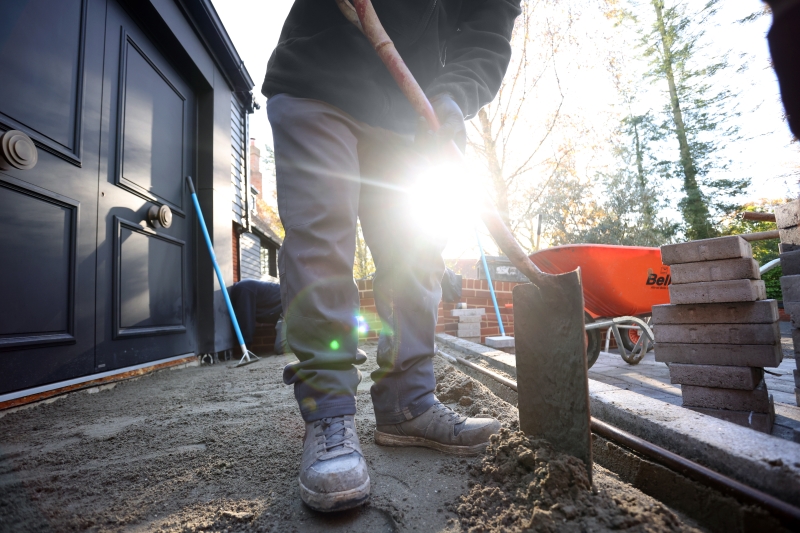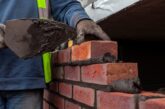
Recent advancements in concrete technology are revolutionising its sustainability, application and finish. Mike Edwards, Group Head of Sustainability at Marshalls explores what these mean for builders.
Traditionally, concrete has been seen as a solely practical material – chosen for its strength and durability rather than how it looks. But now, leading manufacturers are making big innovations to transform its carbon footprint and update its overall appeal – while ensuring the installation process itself isn’t affected.

Reducing the carbon footprint
To reduce the carbon footprint of concrete, manufacturers are looking at the levels of cement in their typical mix designs. Cement typically accounts for about 88% of the emissions associated with the average concrete mix, therefore bringing down the amount of cement used helps reduce its impact. Importantly, manufacturers have been able to make this change without impacting on performance.
Some manufacturers are going even further by using alternative binders instead of traditional cement. Although replacing a small percentage of cement is relatively easy, creating a mix where substitutes outnumber cement is much harder. Despite this, leading manufacturers have taken on the challenge, and their progress is now reflected in updated Environmental Product Declarations (EPDs).
Innovating once again, leading manufacturers are also developing cement-free mixes that will drastically reduce the environmental impact of concrete products. While these developments might not be long-term solutions, they will provide a vital stepping stone to the ultimate goal of lower or even zero-carbon cement.

Understanding EPDs
An Environmental Product Declaration or EPD is a detailed, independently verified document reporting a wide range of the environmental impacts of a product. Here are some key things to know about EPDs:
- To create an EPD, a manufacturer or supplier compiles detailed information about the whole life cycle of a product, including component materials, the distance those materials travelled to the factory, energy used in manufacturing, packaging and the average distance the finished product travels to its end use.
- The EPD measures different stages in a product’s life cycle. This could be ‘cradle-to-gate’ – its journey from raw material to it leaving the factory gate, or ‘cradle-to-grave’ – from manufacture to its end of life. Make sure what you are comparing like for like when considering different materials.
- The outputs of an EPD are where you compare the results of all the innovations and improvements that manufacturers and their supply chains are doing to reduce the environmental impacts – particularly the product’s carbon footprint, which appears as ‘GWP total’ on an EPD
Concrete vs clay
To understand the true environmental benefits of using concrete in more building projects, in recent research, Marshalls found the housebuilding sector could dramatically reduce its carbon footprint by switching from clay-facing bricks to concrete-facing bricks.
Following the publishing of a new Environmental Product Declaration (EPD) for its Concrete Facing Brick, Marshalls has uncovered that for every tonne of concrete-facing bricks used instead of more traditional clay facing bricks, housebuilders could cut the total carbon lifetime footprint by almost half (49.1%). This equates to 116.50 kilograms of CO2e per tonne of bricks.
When scaled to the total number of bricks used to construct homes during 2023 – approximately 1.1 billion – the carbon footprint savings are substantial. If all dwellings built in the UK during 2023 were constructed using concrete-facing bricks, the UK could have saved 214,057 tonnes of CO2e. This is equivalent to removing 105,663 diesel cars off the road for a year.
Should more builders opt to switch from clay to concrete, they could contribute to a significant reduction in carbon use that could see the industry make a real difference in the fight against climate change – all without needing to change anything in the typical installation or building process.
A flourish in the finish
And there’s more. The latest formulations of concrete enhance its durability and improve its resistance to common issues like staining, fading, and frost damage. This extended lifespan of its finish also means concrete is a cost-effective choice in the long run.
There are further developments in the aesthetics of concrete, too. New innovations are transforming it into an attractive option for builders, tradespeople and landscapers to use on a wide range of projects – and critically, with ease.
For example, the latest concrete surface printing technology can create patio and driveway pavers that combine a premium aesthetic with easy installation, low maintenance and durability. Harnessing over a decade of innovation, these stylish printed concrete pavers are available in a wide range of colours and on-trend designs, and feature excellent colour consistency between batches. What’s more, due to their printed surface-coated design, the newest solutions have a protective layer that shields the surface from stains, fading from UV light, frost and abrasion. As well as providing slip resistance to an enhanced slip/skid rating, the protective layer also defends against the possible risk of efflorescence – when salt deposits rise to the top of a surface – which is sometimes experienced with concrete products.
For those using them in their projects, one of the most significant advantages is time and labour savings. As they are made from concrete, these pavers can be cut without specialist blades and laid in the same way as ordinary concrete or block paving, according to application.
Recent advancements in concrete technology from the industry’s most innovative manufacturers have transformed it into a material that now meets and exceeds modern construction demands. Today, concrete is no longer just a grey, functional material of the past – it’s the foundation of modern design and innovation. All these benefits can be achieved with just a simple switch to innovative concrete products, meaning builders have the opportunity to futureproof their projects without straying from the installation techniques they know and trust.
For more information on Marshalls visit Leading Supplier of Hard Landscaping, Building, and Roofing Products | Marshalls.








